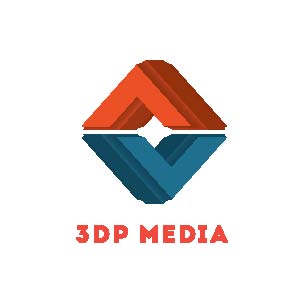Traditional Modes Of Teaching Will Not Serve Students Seeking To Gain Insights, Instruction & Inspiration From 3DP In Classroom Settings: Educators Need To Innovate In The Ways They Utilize 3DP As Both A Teaching Tool & A Curriculum…
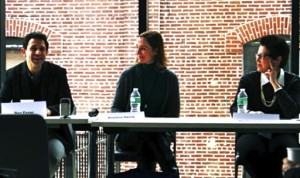
Technical.ly Brooklyn “Diversity In/Tech” Panel at the Brooklyn Navy Yard, January 2014: (from left) Ben Esner, Director of K-12 STEM Education at NYU-Polytechnic School of Engineering; Kristina Harris-Petersen, Creator of Math Warriors; Stephanie Cluskey, CEO of NPower. (Photo by Brady Dale.)
The teaching of new things has traditionally been the purview of formal education systems. Of course, the institutions in these systems are generally conservative in nature. So, the closer “new-ness” aligns with the orthodoxy of the established educational organization, the more likely its acceptance, showcasing and pedagogical integration. And, the less likely its value to students hoping to navigate their approaching futures—invariably awash with new-ness that is not susceptible to co-opting or control by the ruling order.
These days, “formal education” purveyors—those organizations with classrooms, matriculated students and credentialed teachers—have less sway than ever as gateways and gatekeepers to the new.
Credit the Internet and its democratization of information. (We’ve talked here of late about the democratization of means to production via 3DP: you could consider 3DP’s alchemic transmutation of “digits to atoms” a subset of DemosInfo.)
So, traditional, college-level educational institutions—whether they know it or not—are now in a life-&-death confrontation with Internet competitors. Consider the available (and advancing!) online information fonts (e.g., BigData), mines (e.g., Crowd-Sourcing) and cornucopia (e.g., every InfoInnov Startup). That’s to say nothing of the knowledge (even wisdom!) derived with more and more facility, insight and trend-spotting from these online resources.
Think “google it,” Wikipedia and MOOCs. This last is an acronym for Massive Open Online Courses. MOOCs are an innovative effort by some major Higher Education Institutions—singularly or in consortia—to control their own online destiny via Web-based courses that provide open access and limitless partaking. The pedagogical jury is still out on whether MOOCs are suicidal…or the road to higher ed salvation.
Even our more local—and less august—K-12 institutions are new expected to address the “new” that technology is injecting into every system in our lives. And, those of our children.
One Rack of MakerBot Equipment & Printing Filament at the World’s First “MakerBot Innovation Center” Debut Ceremony at SUNY New Paltz, 11 Feb 2014
Given the novelty of 3DP, our various educational institutions are slow (prudent? pusillanimous?) on the uptake and inculcation of Additive Manufacturing as pedagogical tool. Still, some are beginning to embrace 3DP systems as levers of teaching.
This tentative-uptake trend will continue to grow. The sheer pressure of accelerating 3DP technology—and its inexorable change-making—will compel the integration of 3D Printing, Additive Manufacturing and Digital Fabrication into novel curricula at educational institutions everywhere: from K-12 to Post Graduate.
Commercial concerns—on the other hand—are eager to “Market-By-Education”—right now! See 3DP desktop-printer manufacturer MakerBot and its Innovation Centers initiative. Leading 3DP companies are challenging schools and colleges to get involved with 3DP.
Some academic insiders, leaders and innovators are also pushing the institutional envelop.
Ben Esner, Director of K-12 STEM Education at NYU-Polytechnic School of Engineering, opined on the obstacles to be overcome in panel-comments at Technical.ly Brooklyn’s Diversity In/Tech event in January at the Brooklyn Navy Yard. This program was about the key role of tech-based jobs in helping our diverse populations, stressed and distressed lower-Middle Class and polyglot have-nots to succeed in today’s challenging workforce environment.
Esner is pushing New York State alignment between policy and rhetoric and practice and realworld. As an example, he pointed out that New York ed leaders and regulators have not put a computer science curriculum in place statewide. So, STEM/STEAM teaching is not appropriately supported—to say nothing of newer classroom concepts like “hands on” 3DP to buttress Project-Based Learning (PBL) and pedagogical innovations like “Design Thinking!”
At the “Inside 3D Printing” Conference & Expo at NYC’s Javits Center on 3 April ’14, a panel entitled “Lessons Learned: 3D Printers in the Classroom” tackled some of the same issues—but at a more “retail” level…
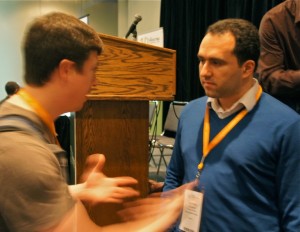
(From left) Brad Chapman, Technology Specialist at Kauffman Labs, conceptualizes with his hands for Panelist Dr. Haytham Elhawary, Exec Director, Zahn Innovation Center, CCNY, CUNY — who had just spoken at “Lessons Learned: 3D Printers in the Classroom,” at “Inside 3D Printing NY” trade show at the Javits Center on 3 April 2014.
Haytham Elhawary, Executive Director of the Zahn Innovation Center at City College of New York/CUNY, buttresses entrepreneurial teaching for his physical-product startups with 3DP. He agrees that “academic change takes a long time” but there is a lot to be done while “approvals are garnered” so “don’t wait to be authorized!”
The real “limitation is imagination.” “Put out low-end printers and let people play…just make it available.” Strive for “disrupted educator minds” from a “very simple start: just print it!”
Fellow panelist Tom Meeks, Training Director at the YouthQuest Foundation (a Virginia, social-solutions, non-profit whose tagline is “Serving America’s At-Risk Youth”) thinks schools should seek out “strategic partnerships” with 3DP equipment providers. (YouthQuest takes its own advice: the Foundation partners with 3D Systems Corporation and its Cubify desktop-3DP product lines.) Tom believes such alliances will provide schools with lower-cost access to equipment AND the all-important support services to help buttress teachers and make their equipment operate effectively.
Then, educators can cobble up an effective curriculum around software teaching.
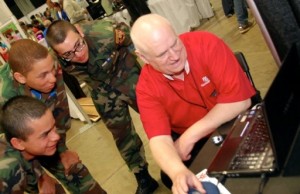
Tom Meeks (in red shirt), Training Director at the YouthQuest Foundation, demo’ing 3D ThinkLink at the USA Science & Engineering Fest, 25-27 April 2014, in Washington DC — a kind of science-fair built large around STEM & STEAM-education perspectives.
Tom found “creativity exploded” when he started implementing YouthQuest’s 3D ThinkLink Initiative. “Drop-outs and the kicked-out…came alive” and the program is “turning around lives.”
3D ThinkLink Initiative is helping students develop critical thinking and problem-solving skills. The program “shows how 3D design and printing helps students learn to think differently, be creative and achieve goals through experimentation and step-by-step improvement.”
Also at “Inside 3D Printing” on 3 April, Steve Kurti—Chief Executive Maker and Mad Scientist at Table Top Inventing—presented a conference-session solo. Steve delivered up his novel perspective around “Educating Makers: The First Step To Revolutionary Change.”
The Maker Ethos has grown up and flourished free of our formal education environment. Makerhood drivers of DIY (Do-It-Yourself) and DIT (Do-It-Together)—from the grassroots-up—don’t intuitively integrate with top-down hierarchical school-organizational forms and formations. Makers ignore (perhaps “distain” might be closer to the mark) controls and credentials by which schools operate and gain credence.
Still, Steve Kurti opines—provocatively!—that we should design our formal education systems to embed “Maker Spaces IN schools.” (Steve champions Maker academic anarchy despite the fact that he holds one of the ultimate academic “credentials”: a Ph.D.!) Further heresy: Steve states that we should start by “teaching the teachers to be involved with Maker Ed.”
Mr. Kurti goes on to suggest that he has discovered “the equation for Maker Education.” It is “Maker Education = Learner + Mentor + Tools.” “The Mentor must set up a good learning environment,” where “deep, rich things begin to happen.” This includes “success soft-skills” that enable students to “share, iterate, cooperate and ‘team’ well and effectively.”
Continuing: Steve Kurti stated that students of every stripe “learn best by doing something.” He used terms like “constructionist learning” and “experiential learning.” “This way of educating matters” because it is “fun, exciting, challenging and unlimited”—the kind of environments that engage students. (A well-developeed subset of these concepts is the aforementioned Project-Based Learning {PBL} and is already on offer at some STEM/STEAM-savvy educational institutions—including programs integrating 3DP equipment with PBL.)
In Steve’s vision of “doing something”-education, “‘wrong’ is just a [temporary] road block” and “nothing is a [fatal] mistake,” but just the “first step toward [real] learning.”
Finally, Mr. Kurti riffed on STEM and STEAM. This latter is a kind of dance wherein “Art is the leap” that we all need to employ to “go back and fill in the steps.” In a nifty peroration, Steve related how a friend had extended these acronyms even further. She came up with eSTEAM—with “the ‘e’ standing for Entrepreneurship.” This is the environment where eSTEAMers become tech-empowered “proactive problem solvers”—inside or outside the formal or informal classroom on the way to starting-up the next business of commercial and common-good importance.
C’mon Back!
LAND

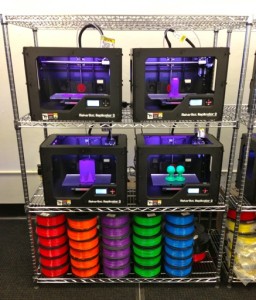
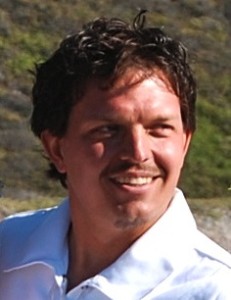
 NYC3DPLand Tweets
NYC3DPLand Tweets